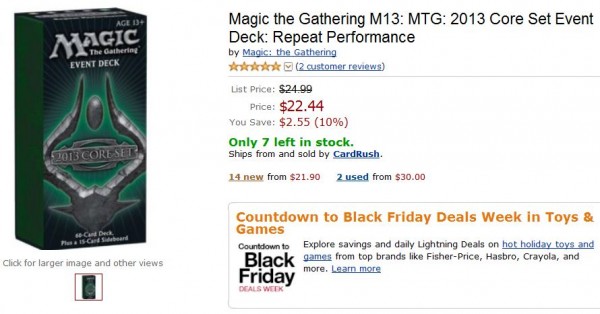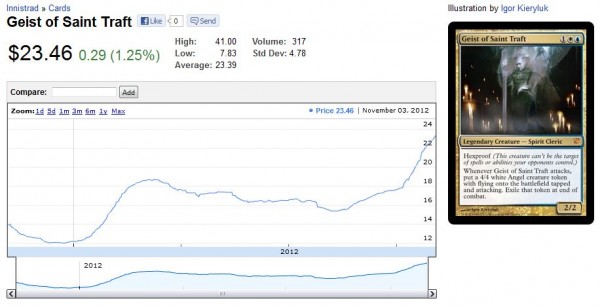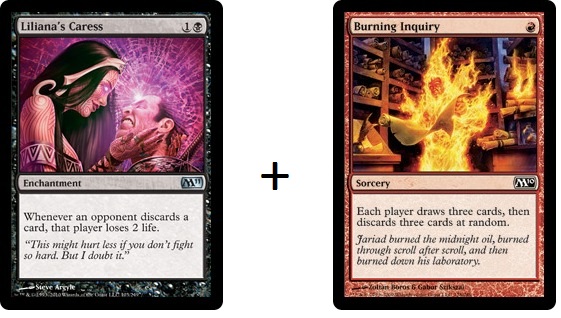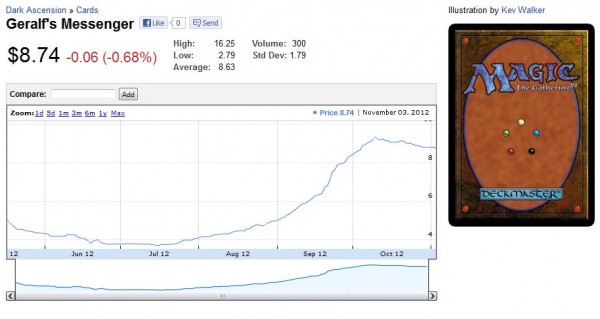Are you a Quiet Speculation member?
If not, now is a perfect time to join up! Our powerful tools, breaking-news analysis, and exclusive Discord channel will make sure you stay up to date and ahead of the curve.
Around three years ago I made the realization that being a strategic Magic Card trader, buyer and seller could help me grow my collection and support my hobby. I've gone from someone who didn’t understand how a player could accumulate wealth through trading to someone who writes for a major Magic website that focuses on finance.
Through this transformation, I’ve made a few sacrifices. One of the toughest sacrifices has been my inability to justify playing Standard competitively. Often times Standard can be a fun format and, for me, being able to play with so many new cards can help to reinvigorate the game. When Legacy is stagnant and Modern is trying to find itself, Standard remains as exciting as ever with Return to Ravnica hitting the metagame.
But as a speculator first and player second, I struggle with playing Standard because of the negative impact holding Standard cards has on my portfolio. Everyone knows how Standard cards drop in value significantly as rotation approaches. Often times, the cards that face the largest price drop are also the cards that are “necessary” to own. But because they are so ubiquitous in the format, they are also often overpriced.
I haven’t played Standard in a few months and am especially regretful since I haven’t had a chance to play the new cards Return to Ravnica brought. This week I will try to assess when and how to break into Standard while minimizing the psychological barrier to entry caused by the knowledge that I may be losing value.
The Problem
Thragtusk is so powerful in Standard. It combines very well with Restoration Angel and helps beat out all the removal spells available in the format. For all these benefits, the creature has a relatively aggressive mana cost. As a result, this M13 rare has reached a price that rivals even Snapcaster Mage.
In fact, currently on SCG the price of Thragtusk is $24.99, while Snapcaster Mage is also $24.99. One major difference: Thragtusk is sold out while there are 47 copies of Snapcaster Mage in stock.
I am somewhat baffled by this pricing. Thragtusk is only a rare, it only sees play in Standard, and it was printed in an Event Deck! And this Event Deck can be had for less than $24.99 at other sites like Amazon.com.
Because I focus on maintaining the value of my collection, I struggle to overcome this discrepancy in order to play Standard. I simply do not agree with the current price of Thragtusk and I personally feel the card will drop in price from here. Why anyone would buy a single copy of the card for $24.99 when they could buy the Event Deck (which also includes 1 Green Suns Zenith, 2 Razorverge Thicket and 2 Dismember) for $22.44 is beyond me.
While Thragtusk is perhaps an extreme example, many hyped Standard cards experience similar price inflation. It can even be more extreme with Mythic Rares. For example, I found it difficult to stomach paying $20 for Geist of Saint Traft. The price is even higher now, and I just know it will drop in value significantly once it rotates out of Standard (chart from blacklotusproject.com).
Don’t even get me started on Bonfire of the Damned, which peaked at the ridiculous price of $49.99 only to come back down to reality once Return to Ravnica shook up Standard.
Possible Solutions
I’ve tested two different approaches to enjoying Standard while not risking hundreds of dollars. A while back I read about the discard deck that combined Megrim and Lilianas Caress.
The deck seemed incredibly fun and somewhat viable. But the best part was the deck was exceptionally cheap! Building a super-budget Standard deck can be rewarding. Stomping over your opponent’s $50 cards with commons and uncommons is a ton of fun. But this deck had two major problems associated with it.
First, it wasn’t close to Tier 1. Punishing an opponent for a sub-optimal draw was doable and did happen on occasion, but the deck wasn’t competitive enough to win tournaments. The second problem was that the deck relied on cards in two different Core Sets. As a result, while the deck cost me less than $20 to build, it was also only legal in Standard for three months.
Budget decks are great because they enable you to play in Standard events cheaply, but it’s very difficult to beat all these overpriced cards. Building a better budget deck right before the format rotates can help you improve win percentages, but only for a couple months. There must be a better way.
Perhaps the only answer is to eat the potential loss in value and acquire the overpriced cards. This approach certainly overcomes the issue of not having a Tier 1 deck. And I suppose if you jump into Standard early enough, your cards will remain Standard legal for at least a year and this can justify the higher cost of entry.
But I must point out one potential downfall with this approach. Currently there are five sets legal in Standard – every time a format rotates, the card pool to build from becomes it’s smallest for a few months. When Gatecrash is released, the card pool will increase dramatically and the number of sets legal in Standard increases by 20%.
With this impactful release, the metagame is sure to shift.
So while getting in early ensures my cards are playable in Standard for the most amount of time, this also sets me up to have cards that become irrelevant in a shifting metagame. If Wizards makes a new guild such as Boros or Simic overly powerful in Gatecrash, some strategies may become obsolete. Even without Gatecrash’s release, we’ve seen the rapid rise and decline of Zombie decks simply due to evolution of the metagame. Had I bought into Zombies early on, I could be sitting on a mound of expensive, undesirable cards destined to drop in price right now (chart from blacklotusproject.com).
It’s a Delicate Balance
Thus, we have a delicate balance in the making.
- Build a deck later and on a budget and you may not have a Tier 1 strategy to play with, full of cards that are destined for rotation, making your deck viable for just a small window.
- Or build a deck earlier to maximize the time you can use your cards, risking succumbing to an evolving metagame that obsoletes your deck.
Perhaps the best time to get in is right now. While Gatecrash hasn’t been released yet, at least the metagame has started to stabilize. Decks like Bant control, Jund midrange, U/W/R midrange, Frites and an array of UW strategies all seem to have established a level of success. And while new strategies may surface when new sets are released, these decks may be robust enough to remain relevant with just a few small tweaks.
At the end of the day the cost of Standard seems so prohibitive. I joke with other players that Legacy and Modern are significantly cheaper to get into because once you own a core group of cards you are able to play a relevant deck for years. Meanwhile, with Standard, you have to constantly acquire new cards to keep your deck fresh and viable in the current metagame. So while I spent more to enter Legacy to start with, I definitely need to spend more cash to maintain a viable Standard deck than a viable Legacy deck.
As an MTG Speculator first and player second, this has been tough for me to stomach. How do you manage?
…
Sigbits – Standard Edition
- Jace, Architect of Thought has finally begun dropping to reasonable prices. This should come as no surprise. Star City Games currently has 40 copies in stock at $39.99 and I’ve been seeing auctions on eBay end in the low $30’s. If Jace remains very strong in Standard, I expect his value shouldn’t drop too much further.
- Since I made the call on Angel of Serenity, I feel obligated to mention that I’ve sold my extra copies. Star City Games has had dozens in stock at $24.99 for a while now, and I could see her price stabilizing or even dropping back down to $19.99. It was a good run nonetheless.
- I’ve slowly begun trading into Shock Lands. It seems Standard players have the copies they need and all extras go right into the trade binder. At the last FNM, players were eager to trade me their Hallowed Fountains and Steam Vents at around $12.50. Not bad considering SCG sells them at $17.99 and $14.99, respectively. Shock Lands may see a little bit more of a price drop, but once Innistrad Block rotates and Return to Ravnica becomes the oldest set in the format, supply will dry up quickly and prices will rebound.
-Sigmund Ausfresser
@sigfig8









“I simply do not agree with the current price of Thragtusk and I personally feel the card will drop in price from here.”
I feel like your approach to prices is holding back your analysis. A price is just a data point that represents the collective actions of market participants, and the more efficient the market the more objective that price is. Ascribing a subjective perspective on prices seems limiting to me. Basically when you say a price is ‘absurd’ or ‘baffling’, you are saying ‘I don’t understand what is going on’. Why not forward hypotheses and then refine and develop your ideas? If you can develop your understanding then it will lead into being able to take advantage of future opportunities.
While I agree with you in principle, I am in a situation where it simply does not make much sense to me to trade for high value standard cards. I have little use for them myself outside of the possible lone copy I might need for EDH and I have few people within easy reach who are looking for standard cards, making me likely to be holding the hot potato if/when the card drops in value. Of course if that changed I should make sure to understand high value from a Standard perspective, but for me in my current position there would be little benefit to trying to formulate a hypothesis on why a card like Thragtusk currently has a high value. My time is better spent trying to do the same for a card like The Abyss that is within my scope (and for which I admittedly am also not sure why it’s suddenly rising, though I do have a guess). I like to stick with what I know.
Similarly the cost/benefit equation for Sig might have a similar result.
@Sig, I’ve pretty much stayed away from standard for the reasons explained, however contrary to yourself, the format does not really draw me either. I find it rather frustrating to know there are better cards in my collection than I could play in the deck but I am not allowed to (specifically Duals). Still, should a card be nice for EDH I do try to obtain a copy, even if I know full well that the price will drop. Thinking of Baneslayers purchased for 30 euros still hurts.
I should probably not even set aside the single copies for EDH usage but just trade or sell them if I come across an opportunity and repurchase/trade only when I absolutely need them for a deck.
@Pi – It does sound like we have the same value equation holding us back from Standard (although I do enjoy the format from time to time). I hate holding Standard cards for too long, and the knowledge that the hot potato may end on me deters me from enjoying the format to its fullest.
I last had a Type 2 legal deck during Invasion/Odyssey blocks Type 2…
Back then I didn’t yet have nearly the collection I have now and many of the players at the university were playing Type 2. Even then I wasn’t all that fond of it, though I liked how one of the guys top 8-ed with a Last Stand deck with Necrologia tech that I suggested. It turned out that Necro-ing in response to an end of turn Fact or Fiction was pretty decent.
Not too much later I started aiming more and more towards serious casual decks and started building my casual oriented collection. To me playing something of the beaten path has always been more fun than the latest and greatest in Type 2. I was also already somewhat aware of the effects of rotation by then and this awareness quickly grew.
In the absolute you are correct – market forces of supply and demand dictate a card’s price and this is an objective process. The problem is, most decisions we make have an emotional slant associated with them. In this case, it is my emotions interfering with my ability to enjoy a format like Standard. I know that if I want to play a winning deck I need to drop 80$ on Thragtusks (for example) and by the time I want to move my Thragtusks, they’ll be $10 each. While I would certainly get enjoyment from using the cards, the logical side of me says why take on that additional cost when it is unnecessary?
It’s an ongoing battle between my desire to enjoy the hobby and my desire to make money from the hobby.
I strictly view my standard deck as an opportunity cost. I want to be viewed as a player at FNM who trades for fun. I do not want to sit in a corner and be a faux dealer.
If you do maintain a tier 1 standard deck and are a reasonably good player you should be balancing out the loss of value with prizes won from tournaments. I feel like it’s very much worth attending FNMs for the prizes,trade opportunities and to further understand the market. When you go to fnm and every third person there is asking for Swagtusks (still) you’d understand why he’s able to command and hold a $25 price as well as witnessing first hand the reason entreat the angels is going down (sever the bloodline) or sigarda is probably still a pickup.
This is a strong point. My personal situation holds me back at times because of my wife and baby boy. Going to FNM’s until 11:00 at night is very suboptimal for my family, so I often cannot stay long enough to earn those prizes. A personal choice but an impactful one nonetheless.
I take the expensive price of ‘staple’ standard cards as a challenge. There are always enough bulk rares and semi-bulk rares that add up into a competitive deck. It might not quite be tier 1, but it gets close. Instead of a deck of >$20 rares, use a deck of $10 rares that don’t fluctuate as much.
For example, while Delver was the format I built a mono white that could match or even outpace Delver with Silverblade, Nearheath Pilgrim, and Angel of Jubilation. W/o Phyrexian mana almost every Delver deck got shut down. The most expensive cards in my deck were caverns to ensure the angel. Once the angel was down, I just hold faith’s shield to keep it from being bounced. I consistently won every fnm so I used the winnings as funding for the deck and got stuff like Champion of the Parish and Elite Inquisitor (which combined with Celestial Purge destroyed zombies easily).
Mainly, I just hold onto dual/shock lands regardless of price (only exception has been woodland cemetery). They’re sure to be worth money later, so I don’t mind keeping them so that when I do build a standard deck my mana base is solid.
This is an interesting approach and one I should consider trying. I enjoy playing Tier 1.5 Standard decks as a challenge to “get there” against all the expensive decks. What deck would qualify for this description now?
Right now, it seems like there’s RDW for hyper-aggro, GW-Midrange (doesn’t use thragtusk) with a combination of rancor, silverblade, silverheart, Sublime. Epic Ex mill seems to be possible with temporals, and UR tempo control with electromancer, guttersnipe, and counters. Finally, I’m using a man-artifact removal build that has: 4x Supreme, 4x Sever the Bloodline and the GW and UW keyrunes. The other slots are all situational and based off of the meta at my LGS. Each of these decks are have hard counters that exist (besides maybe the RDW and GW) so they aren’t exactly T1, but they’re close in the right meta.
Man… This seems repetitive…but i couldn’t agree more with everything you said…is just you read my mind :D. Even the baby issue applies :). I used to play standard a lot and assume that as a natural loss, for fun. However, after rotation, knowing that RTR was overpriced I shifted to EDH….and waited. Now i am going back to standard, mainly because of a GPT trial for lisbon that is going to be done in my local magic club as T2 (as Bant or U/W/R)… However, I am still not sure what I am going to do after. Maybe I will stick around for a few time (At least the shocklands shouldn’t drop that much 🙂 )… but without doing big deck changes.
Thanks for the comment, drackmorph! It’s reassuring to hear that there are others in the MTG community experiencing the same dilemmas as I am. Balancing competitive play with family can be tough, and when the competitive play also drops the value of your collection it is almost too much for me to stomach. But I feel like this format is a lot of fun and I am missing out by not playing. I may try one of these Tier 1.5 decks. Epic Experiment does look fun and cheap…
play modern/legacy. draft standard. in legacy there are multiple deck archtypes to choose from. thragtusk isn’t in every deck, etc.
i ran a psychic spiral deck at a GPT locally. no epic experiment ’cause i flipped it but i still went 3-2-1 tieing and losing to 2 that made top 8.
I think there it is a fallacy that you can’t have a collection reserved for playing and a collection for profit. Think about cash – you have cash to pay the bills, some for savings, and some for going out and having fun. If an old friend calls you up to go out to dinner, you (hopefully!) don’t say ‘going to dinner used to be fun, but now I can’t justify spending the money when I could be investing it’. Spending money is designated to be spent on memories and experiences.
Do the same with magic – use spending money or cash out some investment to buy a deck and a season of playing and think of it as completely separate from your investment bankroll.
On the topic of playing standard on a fixed budget, rather than recommending investing in specific tier 1.5 – 2 decks I recommend investing in your favorite color combination or shard. Get all the expensive cards and tweak your deck all season. Learn when U/W should be be aggro/control and when it should be slow control – Restoration Angel and Snapcaster are good in both. If you buy all the good Bant cards learn when you should be playing G/W ramp and when you should be playing U/W tempo. Be open minded enough to play cards that don’t see high level play when they will be good in your local metagame – Champion of Lambholt can be a blowout if no one plays much removal. By committing to a color combination and brewing a new strategy in those colors each time the metagame shifts you can play the same cards competitively all season.
You make a valid point, and one worth considering. This blurs the line between investing in magic and playing magic as a hobby. I used to strictly do the latter and I had a ton of fun playing. But as my friends moved away, I got married, and had a baby my time to play has diminished and so I’ve shifted to investing in Magic. It’s difficult to keep both separate in my mind. How do you do this?
Right now I am almost purely in the play magic as a hobby camp. Engaged, bought a house, just got a new dog. Spending money budget supports playing as much as I have time for so playing is my choice – time is more scarce than money. Recently realized how much I could save / how many more deck options I have just by trading between rounds.
Considering getting into cash specs and if I did I would treat it like I did when I played online poker- I am buying this video game with spending money and the money is now virtual. Keeps you emotionally divested from risks and losses and keeps you out of trouble with needing the money.